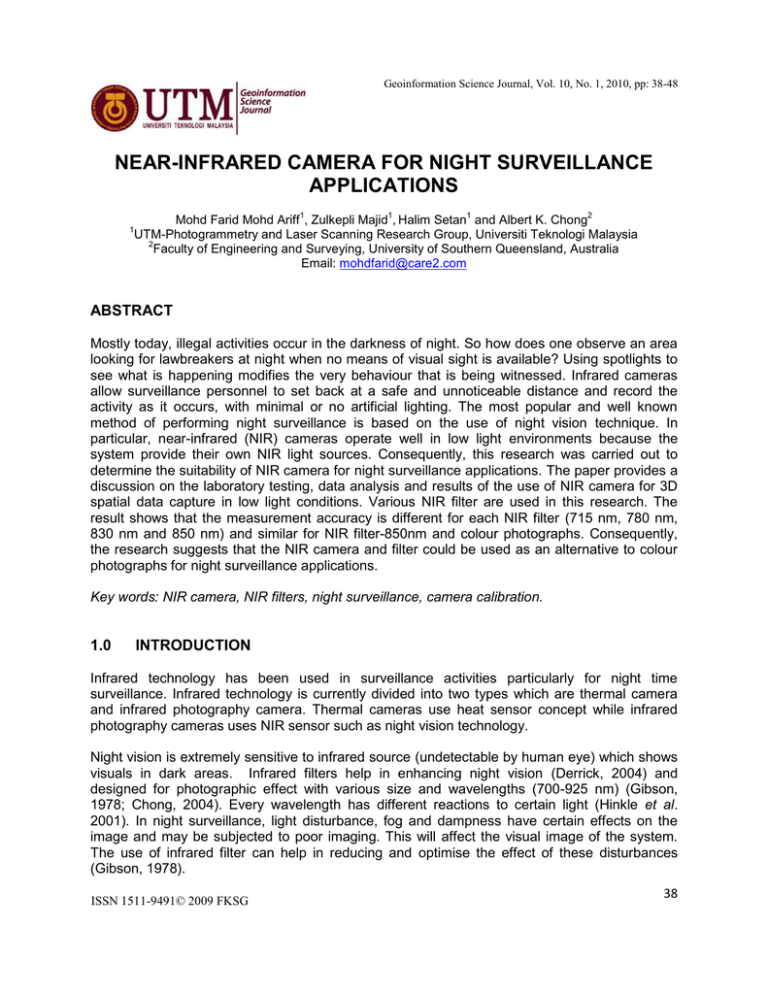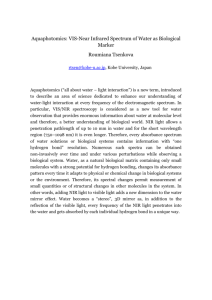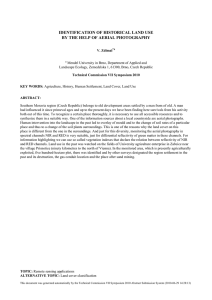NEAR-INFRARED CAMERA FOR NIGHT SURVEILLANCE APPLICATIONS
advertisement

Geoinformation Science Journal, Vol. 10, No. 1, 2010, pp: 38-48 NEAR-INFRARED CAMERA FOR NIGHT SURVEILLANCE APPLICATIONS 1 1 1 2 Mohd Farid Mohd Ariff , Zulkepli Majid , Halim Setan and Albert K. Chong UTM-Photogrammetry and Laser Scanning Research Group, Universiti Teknologi Malaysia 2 Faculty of Engineering and Surveying, University of Southern Queensland, Australia Email: mohdfarid@care2.com 1 ABSTRACT Mostly today, illegal activities occur in the darkness of night. So how does one observe an area looking for lawbreakers at night when no means of visual sight is available? Using spotlights to see what is happening modifies the very behaviour that is being witnessed. Infrared cameras allow surveillance personnel to set back at a safe and unnoticeable distance and record the activity as it occurs, with minimal or no artificial lighting. The most popular and well known method of performing night surveillance is based on the use of night vision technique. In particular, near-infrared (NIR) cameras operate well in low light environments because the system provide their own NIR light sources. Consequently, this research was carried out to determine the suitability of NIR camera for night surveillance applications. The paper provides a discussion on the laboratory testing, data analysis and results of the use of NIR camera for 3D spatial data capture in low light conditions. Various NIR filter are used in this research. The result shows that the measurement accuracy is different for each NIR filter (715 nm, 780 nm, 830 nm and 850 nm) and similar for NIR filter-850nm and colour photographs. Consequently, the research suggests that the NIR camera and filter could be used as an alternative to colour photographs for night surveillance applications. Key words: NIR camera, NIR filters, night surveillance, camera calibration. 1.0 INTRODUCTION Infrared technology has been used in surveillance activities particularly for night time surveillance. Infrared technology is currently divided into two types which are thermal camera and infrared photography camera. Thermal cameras use heat sensor concept while infrared photography cameras uses NIR sensor such as night vision technology. Night vision is extremely sensitive to infrared source (undetectable by human eye) which shows visuals in dark areas. Infrared filters help in enhancing night vision (Derrick, 2004) and designed for photographic effect with various size and wavelengths (700-925 nm) (Gibson, 1978; Chong, 2004). Every wavelength has different reactions to certain light (Hinkle et al. 2001). In night surveillance, light disturbance, fog and dampness have certain effects on the image and may be subjected to poor imaging. This will affect the visual image of the system. The use of infrared filter can help in reducing and optimise the effect of these disturbances (Gibson, 1978). ISSN 1511-9491© 2009 FKSG 38 Geoinformation Science Journal, Vol. 10, No. 1, 2010, pp: 38-48 Night vision is commonly used in night surveillance at low-light security or condition involving totally darkness. Infrared cameras with night vision function are ideal device for anyone needs to monitor in the dark for work or pleasure. Infrared cameras use infrared light (illuminator) instead of the regular lighting spectrum in order to produce better images in complete darkness or low light condition. Today, many surveillance systems consist of day and night version cameras. It mean that cameras can automatically or manually switch between day mode with colour video and night mode with black and white low light image. This research was required to determine the suitability of NIR camera for night surveillance applications. The paper provides a discussion of the laboratory testing of the use of NIR camera for 3D data captured in low light condition based on various NIR filters. The results of NIR photography for each NIR filter and conventional colour photography are compared in order to evaluate the potential of NIR for further research (e.g. forensic mapping). Camera calibration for colour and NIR data-sets is reported. Tests were conducted on mannequins. 2.0 METHODOLOGY The research entails two stages. First stages involves the calibration of the Sony HC-5E HDV cameras to determine their principal distances for colour and NIR imaging. The next comprises the testing of the colour and NIR photographs using mannequins (Figure 1). Initially, mannequins were used to avoid any error due to movement in order to determine the potential accuracy. A C E F B D Figure 1: Mannequin 2.1 Equipment and Software One Sony HC-5E HDV camera (6 megapixels) was used in the research (Figure 2). The camera is capable of taking colour and NIR photographs. A built-in NIR light source (700 to 930 nm) which is located at about 10 mm below the lens was used to illuminate the target while NIR photographs were taken. Figure 3 shows a set of four NIR filters were used in the research. Each filter is designed with a specific range of wavelength (715 nm, 780 nm, 830 nm and 850 nm). 39 Geoinformation Science Journal, Vol. 10, No. 1, 2010, pp: 38-48 Figure 2: Sony HDV (HC-5E) and Infrared Illuminator Figure 3: NIR Filters Figure 4 shows a portable calibration frame that used in the research. Retro-targets were placed on the frame and on the bracing at three level of depth (0 mm, 75 mm and 150 mm). Retro-targets are highly reflective targets, which are specially made for precise automated digitizing (Atkinson, 1996). The coordinates of the retro-targets on the portable control frame were obtained photogrammetrically. Figure 4: A Portable Calibration Frame 40 Geoinformation Science Journal, Vol. 10, No. 1, 2010, pp: 38-48 Australis photogrammetric bundle adjustment software (Version 6.04, 2002) was used to obtain high precision image coordinates from the digital images (Fraser and Edmundson 2000). The software was used to carry out photogrammetric computations, which included relative orientation, space resection, triangulation, bundle adjustment and measurement. 2.2 Calibrating the Camera For ultra-high precision 3D spatial data capture the cameras must be calibrated. Standard nonmetric camera calibration is well documented (Fryer, 1989; Beyer 1992; Peterson et al. 1993; Fraser and Edmundson 1996). This process includes the determination of the principal point of autocollimation (PPA), the principal distance (PD), the radial lens distortion parameters (k 1, k2 and k3), and in some instances the dynamic fluctuation. The HDV cameras were calibrated based on colour and NIR photographs. The HDV was mounted on a tripod. The position of the HDV mount and the calibration frame were adjusted so that the object distance of 3.0 m would be similar to the object distance of the mannequin subject stereo photography. The 3.0 m object distance was found to be suitable for the chosen video and further research (e.g. forensic mapping). The PD was set to a wide-angle setting of 5.1 mm. Convergent imagery of the portable calibration frame was taken by tilting the calibration frame through four different rotations (Karara, 1989) (Figure 5). These rotations simulated a set of four convergent image of the set-up. Each set-up was repeated four times. The colour imaging technique of the HDV was used first and this was followed by the NIR imaging technique. All the convergent photographs were digitized in auto mode using Australis. A self-calibration technique was used because this technique does not require a set of known object-space coordinates of the targets photographed (Cooper and Robson, 1996). 1st Rotation 3rd Rotation 2nd Rotation 4th Rotation Figure 5: Four Different Rotations 41 Geoinformation Science Journal, Vol. 10, No. 1, 2010, pp: 38-48 2.3 Stereoscopic Photography Again, HDV camera was used to capture stereo convergent imagery of the mannequin. The PD camera was set to a wide-angle setting of 5.1 mm and other electronic settings such as ISO, aperture, metering mode, exposure value and colour tones were set to default and the shutter speed was set to auto. Initially, the tests were performed on mannequin to determine whether colour and NIR photography would have an effect on the measurement always of the same subject. Each test was repeated four times. A total of twenty sets of stereopair were obtained for colour (four sets) and NIR photography (sixteen sets). For each type of NIR photography, four tests were carried out which consist of four NIR wavelengths study: (i) 715 nm, (ii) 780 nm, (iii) 830 nm and (iv) 850 nm. Figure 6 shows example of the data. 715 nm 780 nm 830 nm 850 nm Figure 6: Effect of Different Wavelength on NIR photography 3.0 RESULTS AND ANALYSIS The results of four sets of camera calibration for each set-up are shown in Table 1. Table 1: Camera Focal Length Results Set-up Focal Length ‘c’ (Means from four set data) Colour Photography 5.118 mm NIR Photography Filter-715 nm Filter-780 nm Filter-830 nm Filter-850 nm 5.168 mm 5.175 mm 5.175 mm 5.183 mm 42 Geoinformation Science Journal, Vol. 10, No. 1, 2010, pp: 38-48 Table 1 shows the ‘c’ for colour photography is shorter than the ‘c’ for NIR photography by about 50 micron (filter-715 nm), 57 micron (filter-780 nm), 56 micron (filter-830 nm) and 64 micron (filter-850 nm). A student’s t-test (tα (0.05)) shows that different between the means (colour photography vs. each NIR filter) is significant (H0: µ1-µ2=0 was rejected). Based on analysis of variance (Anova), the standard deviation of the computed ‘c’ of the colour photography is larger than the NIR photography (Table 2). Table 2: Mean and Std. Dev. of the Computed ‘c’ (Focal Length) Consequently, it implied that both NIR and colour photography have a different focal length ‘c’. For NIR photography it has demonstrated that focal lengths ‘c’ for each NIR filter are slightly different with the very small values (Figure 7). As the object distance was set to the same value for both types of photography no errors are expected from changes in the distance from this source. . Four set data Means Figure 7: Chart - Focal Length Vs Colour/NIR Photography 3.2 Photographic Measurement Stage 2 involves the measurements obtained from the mannequins. Three-dimensional distances (3Ds) between targeted landmarks were used to compare the computed object-space 43 Geoinformation Science Journal, Vol. 10, No. 1, 2010, pp: 38-48 dimensional accuracy between NIR and colour photographs. The 3Ds were used instead of object-space coordinates to avoid any potential errors originating from slight displacements of the mannequin in between sets of stereo photography. The distances which were regarded as true were determined by a set of eight convergent photographs, two scale bars and photogrammetric bundle adjustments. The six longest 3Ds distances from the six targeted landmarks (Figure 1) were used in the comparison. Each test consisted of five sets and each set generated six 3D distances. Accordingly, 30 3Ds distance were used in each of the tests. The results of the tests performed on mannequins are presented in Tables 3. The mean and standard deviation of the stereodigitising results of the colour and NIR photography are presented. Considering the whole data-set, most of the mean accuracy values are lower than or close to the 1.0 mm. The mean accuracy values of the NIR filter-850 nm photographs are of similar magnitude (less than 0.6 mm) to the mean accuracy values of the colour photographs. Table 3: Difference between the true and measured 3Ds versus colour/NIR photography Point/ Test Colour NIR 715 nm 780 nm 830 nm 850 nm Point/ Test Colour NIR 715 nm 780 nm 830 nm 850 nm Point/ Test Colour NIR 715 nm 780 nm 830 nm 850 nm A-B (mm) Mean Std Dev 0.4 0.4 C-D (mm) Mean Std Dev 0.4 0.4 0.9 0.5 0.7 0.5 -0.8 0.4 0.3 0.2 E-D (mm) Mean Std Dev 0.4 0.5 0.8 0.4 0.8 0.5 0.7 0.5 0.4 0.3 F-B (mm) Mean Std Dev 0.5 0.4 0.8 0.5 0.7 0.4 -0.7 0.5 0.4 0.2 E-F (mm) Mean Std Dev 0.5 0.4 0.8 0.4 -0.7 0.4 -0.8 0.4 0.3 0.2 B-D (mm) Mean Std Dev 0.4 0.5 0.9 0.9 0.8 0.4 0.4 0.4 0.5 0.3 0.9 -0.7 -0.8 0.4 0.5 0.4 0.4 0.2 This suggests that NIR filter-850 nm photography has the potential to be used to acquire 3D spatial data and measurements in low light condition. The standard deviation for all data was consistently in a range of 0.4 to 0.5 mm except for NIR filter-850 nm which shows a standard deviation less than or close to 0.3 mm. A statistical Student’s t-test (tα (0.05)) shows that the differences between the means and standard deviations (all data vs. colour) are significant (H0: µ1-µ2=0 was rejected). 44 Geoinformation Science Journal, Vol. 10, No. 1, 2010, pp: 38-48 4.0 CONCLUSIONS This project attempted to determine whether digital NIR photography could be used for photogrammetric mapping of human features (based on mannequin) as an alternative to traditional colour photography. The results show that the accuracies of measurement on the mannequin are similar for both colour and NIR photography (especially filter-850 nm). Most of the mean accuracy values for all photography setup are lower than or close to the 1.0 mm. The standard deviation for all data was consistently in a range of 0.4 to 0.5 mm except for NIR filter-850 nm provides standard deviation less than or close to 0.3 mm. Consequently, the results showed that NIR photography (filter-850 nm) constitutes a potential alternative for 3D spatial data capture in low light condition. Further research will investigate the suitability of NIR images for forensic measurement of night surveillance images. There are several advantages of using NIR photography for mapping human features, especially for forensic mapping. Firstly, NIR photography requires less lighting resources and can be used in low light conditions. Many NIR/night surveillance images today are greatly enhanced with the use of NIR filters. Secondly, the stereo-images seemed to present fewer glares to the human eye, thus making stereodigitising less of a strain on the eyes (Chong and Mathiew, 2006). Certainly, there is potential for NIR imaging techniques in close range photogrammetric applications. ACKNOWLEDGEMENTS The author acknowledges financial assistance for this research from Ministry of Science, Technology and Innovation (MOSTI) for Scholarship of Postgraduate Fellowship Scheme (PGD) and e-science fund vote 79141. REFERENCES Atkinson, K.B. (Ed) (1996). Close Range Photogrammetry and Machine Vision. Whittles Publishing, Caithness, Scotland, 371 pages. Beyer, H.A. (1992). Geometric and Radiometric Analysis of CCD-camera based Photogrammetric Close-Range System. Institute for Geodesy and Photogrammetry, ETH Honggerberg, Zurich. 186 pages. Chong, A.K. (2004). Digital Near-infrared Camera for 3D Spatial Data Capture. The 16th Annual Colloquium of the Spatial Information Research Centre, University of Otago, Dunedin, New Zealand. November 29-30, 2004. Chong, A.K. and Mathiew, R. (2006). Near Infrared Photography for Craniofacial Anthropometric Landmark Measurement. The Photogrammetric Records 21(113): March 16-28, 2006. 45 Geoinformation Science Journal, Vol. 10, No. 1, 2010, pp: 38-48 Cooper, M.A.R. and Robson, S. (1996). Vision-Based Automated Measurement Technique. In: Close Range Photogrammetry and Machine Vision. (Ed. K.B. Atkinson). Whittles, Caithness, 371 pages. Derrick, (2004). Adobe Studio and Adobe Photoshop CS: Infrared Photography Goes Digital. O’Reilly Media, Inc. Fraser, C.S. and Edmundson, K.L. (1996). The Metric Impact of Reduction Optics In Digital Cameras. Photogrammetric Record. 15(87): 437-446. Fraser, C. S. and Edmundson, K. L., 2000. Design and implementation of a computational processing system for off-line digital close range photogrammetry. ISPRS Journal of Photogrammetry & Remote Sensing, 55(2): 94–104. Fryer, J.G. (1989). Camera Calibration in Non-topographic photogrammetry. In: Nontopographic Photogrammetry. (Ed. H.M. Karara). 2nd Edition. American Society for Photogrammetry, 445 pages: pp. 59-68. Gibson, H.L. (1978). Photography by Infrared: Its Principles and Applications. A WileyInterscience Publications, John Wiley & Sons, New York. Hinkle, K.H., Joyce, R.R., Hedden, A. and Wallace, L. (2001). Wavelength Calibration of Near Infrared Spectra. Publications of the Astronomical Society of the Pacific. 2001, May. 113: 548566. Peterson, A.E., Durdle, N.G., Raso, V.J. and Hili, D.L. (1993). Calibration of Video Cameras for Scoliosis Mapping. Geomatica, 47(1): 29-38. AUTHORS Mohd Farid Mohd Ariff is a PhD student at the Faculty of Geoinformation and Real Estate, Universiti Teknologi Malaysia. Currently, he is an active member of Photogrammetry and Laser Scanning Research Group. He holds B.Eng. (Hons.) (Geomatic Engineering) degree and M.Sc (Close Range Photogrammetry) degree from Universiti Teknologi Malaysia, Malaysia. His Ph.D research lies in the area of close range photogrammetry for forensic applications. 46 Geoinformation Science Journal, Vol. 10, No. 1, 2010, pp: 38-48 Dr. Zulkepli Majid is a senior lecturer at the Faculty of Geoinformation and Real Estate, Universiti Teknologi Malaysia. Currently, he is the head of Photogrammetry and Laser Scanning Research Group. He holds B.Sc.(Land Surveying) degree, M.Sc (Photogrammetry) degree and a Ph.D (Medical Photogrammetry) degree from Universiti Teknologi Malaysia, Malaysia. His research interests lie in the areas of Photogrammetry and Laser Scanning for various applications. His current research projects are the application of photogrammetry in forensic and assets data capture using terrestrial laser scanner. Dr. Halim Setan is a professor at the Faculty of Geoinformation and Real Estate, Universiti Teknologi Malaysia. He holds B.Sc. (Hons.) in Surveying and Mapping Sciences from North East London Polytechnic (England), M.Sc. in Geodetic Science from Ohio State University (USA) and Ph.D from City University, London (England). His current research interests focus on precise 3D measurement, deformation monitoring, least squares estimation and 3D modeling. Dr. Albert K. Chong is a senior lecturer at the Faculty of Engineering and Surveying, University of Southern Queensland. He holds B.Sc in Photogrammetry from California State University, Fresno, M.Sc. (Civil Engineering) from the University of Washington and a Ph.D (Civil 47 Geoinformation Science Journal, Vol. 10, No. 1, 2010, pp: 38-48 Engineering) from The university of Washington. His research interests lie in the areas of close range photogrammetry and close range laser scanning. He has authored over 137 articles in both international and national refereed journals, conference proceedings, and workshop in field of engineering, surveying, photogrammetry, laser scanning and GPS. 48





